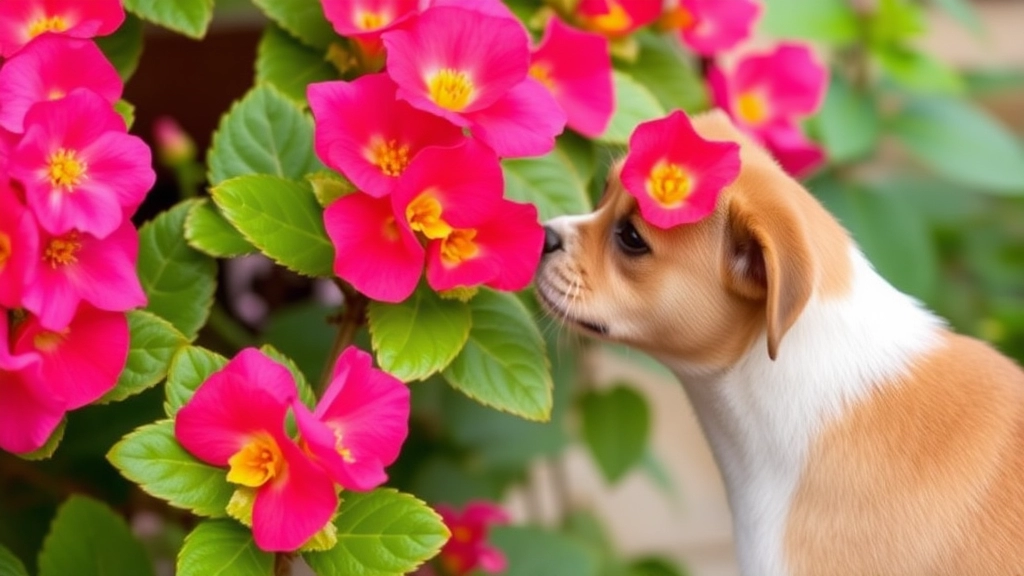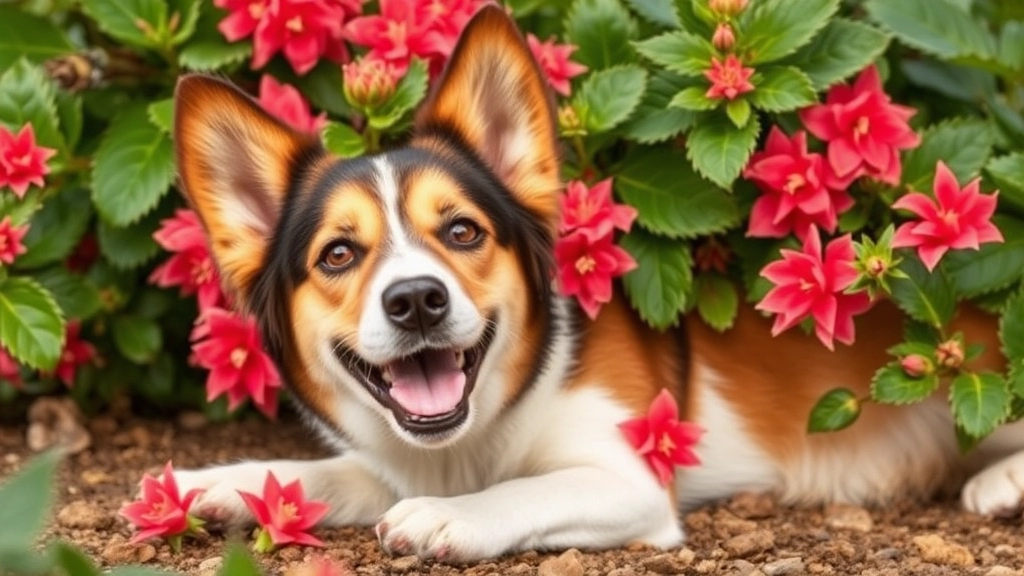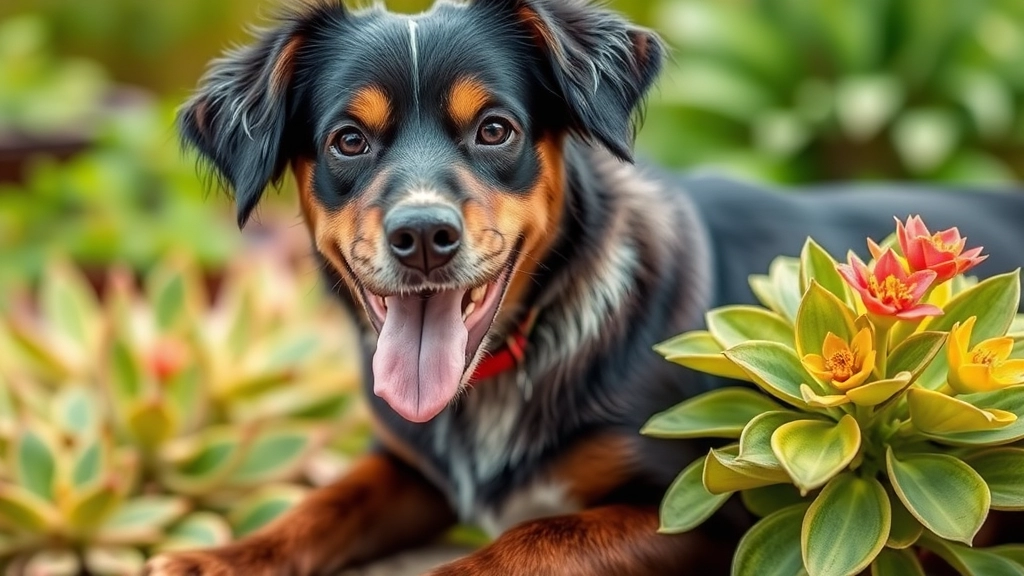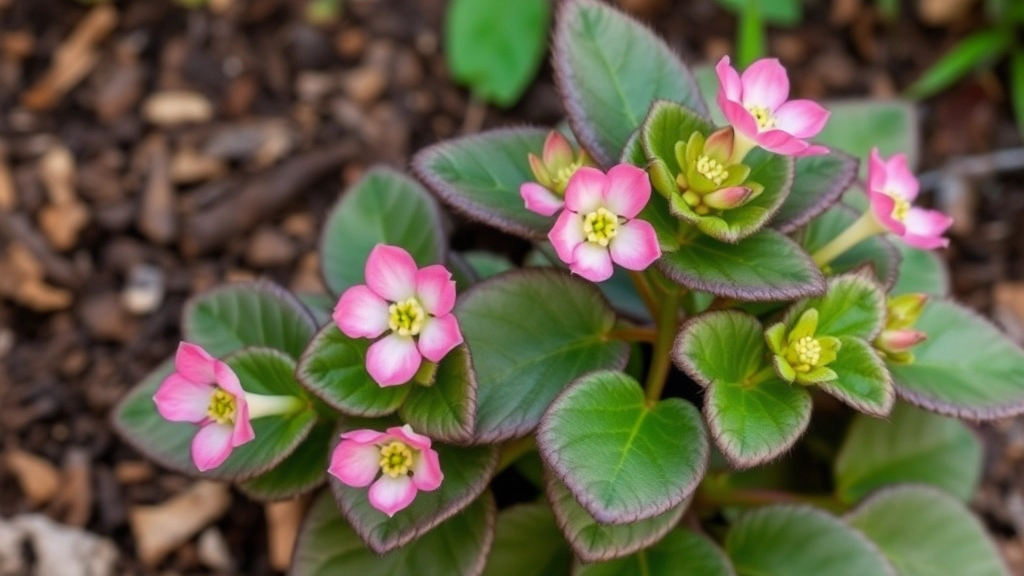Is Kalanchoe Safe for Dogs?
Ever wondered if your beloved pooch is safe around houseplants? If you have a Kalanchoe in your home, you need to be aware: Kalanchoe is toxic to dogs. This vibrant succulent might add beauty to your space, but it poses a serious risk to your furry friend. Keep reading to learn more about the dangers and how to keep your dog safe.
Understanding the Risks
Understanding the risks associated with Kalanchoe is crucial for any dog owner. Symptoms of Kalanchoe poisoning in dogs can range from mild gastrointestinal issues to severe cardiac complications. If you suspect your dog has ingested any part of this plant, immediate veterinary attention is essential. Stay informed and keep your pets safe from harmful plants.
Common Symptoms of Kalanchoe Poisoning in Dogs
As a dog owner, you may be concerned about the potential dangers of household plants. Kalanchoe, while a popular ornamental plant, can pose a significant risk to our canine companions. Understanding the symptoms of Kalanchoe poisoning is crucial for ensuring your dog’s safety.
Recognising Symptoms
If your dog has ingested Kalanchoe, watch for the following common symptoms:
- Vomiting: This is often the first sign and may occur within hours of ingestion.
- Diarrhoea: Loose stools can accompany vomiting, leading to dehydration.
- Lethargy: Your dog may seem unusually tired or disinterested in activities they normally enjoy.
- Loss of Appetite: A sudden refusal to eat can indicate distress.
- Abdominal Pain: Signs may include whining, pacing, or a hunched posture.
- Tremors or Seizures: In severe cases, neurological symptoms may occur.
These symptoms can vary in intensity based on the amount ingested and the individual dog’s health.
If you notice any of these signs, it’s essential to act quickly. Early intervention can make a significant difference in your dog’s recovery. For more information on how to protect your pets, check out our guide on Kalanchoe toxicity and pet safety. Additionally, understanding the symptoms and safety tips for Kalanchoe poisoning in humans can further ensure the safety of your household.
How Kalanchoe Affects Canine Health

So, you’re worried about your furry friend munching on that pretty Kalanchoe plant, right? You’re not alone. Many dog owners share the same concern, and it’s totally valid.
Kalanchoe contains compounds called bufadienolides, which can be toxic to dogs. When ingested, these compounds mess with your dog’s heart and overall health. Here’s what you might notice:
- Gastrointestinal Distress: Dogs may experience vomiting, diarrhea, or drooling. Not fun for anyone involved!
- Cardiac Issues: The heart can take a hit, leading to irregular heartbeats or even more severe conditions.
- Lethargy: If your pup seems unusually tired or sluggish, it could be a sign of Kalanchoe poisoning.
- Seizures: In severe cases, seizures can occur. This is a major red flag.
What’s even scarier is that symptoms can vary based on how much your dog ate and their size. A small dog could have a tougher time than a larger one.
It’s crucial to keep an eye on your pet. If you notice any of these symptoms, it’s time to act fast.
Identifying Kalanchoe Plants in Your Home
As we delve into the specifics of Kalanchoe, it’s crucial to understand how to identify these plants in your home. Recognising Kalanchoe is the first step in preventing potential poisoning in your dog.
Key Characteristics of Kalanchoe:
- Leaf Shape: Kalanchoe plants have thick, fleshy leaves that are often scalloped or serrated. The leaves can vary in colour from green to greyish-green, sometimes featuring a reddish edge.
- Flowers: They produce clusters of small, tubular flowers that can be red, pink, yellow, or white, depending on the species. These blooms usually appear in the spring or summer months.
- Growth Habit: Kalanchoe can grow as a shrub or small succulent. They typically reach a height of about 30-60 cm, making them a popular choice for indoor decoration.
- Texture: The leaves feel waxy and smooth to the touch, which is a distinctive feature of many succulent plants.
Where to Look:
- Indoor Spaces: Check windowsills, living rooms, and other indoor areas where houseplants are commonly placed.
- Gardens and Balconies: If you have a garden or balcony, Kalanchoe may also be found outdoors. They thrive in warm climates.
- Potted Arrangements: Sometimes, Kalanchoe is included in mixed plant arrangements or bouquets, so keep an eye out for them in floral displays.
Understanding these characteristics will help you identify Kalanchoe plants effectively. For more detailed insights on specific varieties, check out our top Kalanchoe Mother of Thousands varieties and care tips. Additionally, if you’re dealing with any leaf issues, our guide on Kalanchoe leaf problems: causes, solutions, and prevention can be incredibly helpful.
Immediate Steps to Take if Your Dog Ingests Kalanchoe

If you suspect that your dog has ingested Kalanchoe, it’s natural to feel a surge of panic. The immediate steps you take can significantly influence your dog’s health and recovery.
Assess the Situation
- Stay Calm: Your dog will pick up on your emotions. Staying composed allows you to think clearly.
- Identify the Plant: Confirm that the plant your dog has ingested is indeed Kalanchoe. Look for its distinctive characteristics, such as its thick, fleshy leaves and vibrant flowers.
- Check for Symptoms: Observe your dog for any symptoms of poisoning, such as:
- Vomiting
- Diarrhoea
- Lethargy
- Abdominal pain
- Changes in heart rate
Contact a Professional
- Call Your Veterinarian: Reach out to your vet immediately. Provide them with details about the incident, including:
- The quantity of Kalanchoe ingested
- The time of ingestion
- Any symptoms your dog is displaying
- Follow Instructions: Your vet may instruct you to induce vomiting or bring your dog in for an examination. Follow their guidance closely.
Prepare for the Vet Visit
- Gather Information: If possible, take a sample of the Kalanchoe plant with you to the vet. This can help in assessing the severity of the situation.
- Monitor Your Dog: Keep an eye on your dog’s symptoms while you prepare to visit the vet. Note any changes, as this information can be crucial for diagnosis and treatment.
Aftercare
- Follow Up: After the vet visit, adhere to any prescribed treatments or follow-up appointments. Monitor your dog for any lingering symptoms or changes in behaviour.
Veterinary Treatments for Kalanchoe Toxicity
If your dog has ingested Kalanchoe, you may be feeling anxious about what to do next. Understanding the veterinary treatments available can help alleviate some of that worry.
When it comes to Kalanchoe toxicity, prompt veterinary intervention is essential. The severity of the symptoms can vary based on the amount ingested, so a vet’s assessment is crucial. Here are some common treatments that your vet might recommend:
- Induction of Vomiting: If ingestion is recent, the vet may induce vomiting to prevent further absorption of toxins.
- Activated Charcoal: Administering activated charcoal can help absorb any remaining toxins in the gastrointestinal tract.
- Intravenous Fluids: To combat dehydration and support kidney function, your dog may receive IV fluids.
- Medications: Depending on the symptoms, the vet may prescribe medications to manage heart rate, control seizures, or alleviate gastrointestinal distress.
- Monitoring: Your dog may need to be monitored for a period to ensure that symptoms do not worsen.
It’s important to act quickly. The sooner you reach out to a veterinary professional, the better the outcome for your dog. For more information on the risks and safety tips, you can read about whether Kalanchoe is poisonous to humans. Additionally, understanding the benefits and risks of eating Kalanchoe can provide further insights.
Preventing Kalanchoe Exposure in Dogs

Worried about your furry friend getting into trouble with Kalanchoe? You’re not alone! Many pet owners share the same concern.
To keep your dog safe, here are some straightforward steps you can take to prevent Kalanchoe exposure:
1. Identify and Remove Kalanchoe Plants
- Check Your Home: Look around your house for any Kalanchoe plants.
- Ask Before Buying: If you’re at a nursery or garden centre, ask staff about the plants they sell.
2. Create a Dog-Free Zone
- Designate Areas: Keep plants in areas that are off-limits to your dog.
- Use Barriers: Consider using baby gates or plant stands to elevate plants out of reach.
3. Educate Yourself and Others
- Share Information: Talk to family and friends about the risks of Kalanchoe.
- Know the Signs: Familiarise yourself with the symptoms of Kalanchoe poisoning.
4. Opt for Pet-Safe Plants
- Research Alternatives: There are plenty of beautiful plants that are safe for dogs.
- Create a Pet-Friendly Garden: If you love gardening, focus on non-toxic varieties.
5. Regularly Check Your Garden
- Inspect for New Growth: If you have a garden, check for any new plants that may have popped up.
- Stay Informed: Keep up with any new plant species that may be harmful.
By taking these steps, you can significantly reduce the risk of Kalanchoe exposure for your dog.
As we explore safe alternatives to Kalanchoe, it’s essential to consider how to keep our furry friends safe while still enjoying beautiful plants in our homes.
If you’re worried about the potential dangers of Kalanchoe in your household, you might be wondering: what plants can I have that are safe for my dog?
Here are some excellent alternatives that will add a splash of greenery without the risk of toxicity:
– **Spider Plant**: This resilient plant thrives in various conditions and is non-toxic to dogs. Its arching leaves can add a delightful touch to any room.
– **Bamboo Palm**: Not only does it purify the air, but it’s also safe for pets. Plus, it brings a tropical vibe indoors.
– **Boston Fern**: Known for its lush foliage, this fern is safe for dogs and can thrive in humidity, making it a great choice for bathrooms or kitchens.
– **Areca Palm**: This attractive palm is pet-friendly and can grow quite tall, making it a stunning addition to your living space.
– **Parlor Palm**: Compact and easy to care for, the Parlor Palm adds elegance without posing a threat to your canine companion.
– **Ponytail Palm**: With its unique appearance, this plant is not only safe for dogs but also requires minimal care.
By opting for these alternatives, you can enjoy the beauty of indoor plants without worrying about your dog’s health. For those who still want to keep Kalanchoe, it’s crucial to understand [why your florist Kalanchoe is not flowering](https://planthq.org/why-your-florist-kalanchoe-is-not-flowering-solutions-and-tips/) and how to make it bloom again. Additionally, you can explore the [health benefits of Kalanchoe Pinnata](https://planthq.org/health-benefits-of-kalanchoe-pinnata-a-complete-guide/) if you’re interested in the plant’s medicinal properties.
Long-term Health Impacts of Kalanchoe Poisoning
So, you’re worried about your furry friend after a Kalanchoe incident.
What happens after the immediate scare?
Kalanchoe poisoning can lead to some serious long-term health issues for dogs.
Here’s what you might want to keep an eye on:
- Heart Problems: Kalanchoe contains compounds that can affect your dog’s heart rhythm. Even if they seem fine initially, there could be lingering effects that pop up later.
- Kidney Damage: Ingesting this plant can stress the kidneys. Over time, this could lead to chronic kidney issues, which are no joke.
- Gastrointestinal Upset: Dogs may continue to have digestive issues even after the initial symptoms fade. This can mean ongoing vomiting or diarrhea.
- Neurological Effects: Some dogs may experience long-term neurological symptoms, like weakness or coordination problems, depending on how severely they were affected.
- Behavioral Changes: Stress and discomfort from poisoning can lead to anxiety or changes in behaviour that might not resolve quickly.
It’s crucial to monitor your dog closely after a Kalanchoe incident. Regular vet check-ups can help catch any long-term effects early on. For more detailed information, you can read about whether Kalanchoe is poisonous to dogs and the essential safety information for pets.
FAQs on Kalanchoe Toxicity to Dogs
What is Kalanchoe?
Kalanchoe is a popular houseplant known for its thick, fleshy leaves and vibrant flowers. However, it contains compounds called bufadienolides, which can be toxic to dogs.
Why is Kalanchoe toxic to dogs?
Kalanchoe contains bufadienolides, compounds that can interfere with your dog’s heart and overall health when ingested.
What symptoms should I look for if my dog has ingested Kalanchoe?
Symptoms of Kalanchoe poisoning in dogs include vomiting, diarrhea, drooling, irregular heartbeats, lethargy, and in severe cases, seizures.
What should I do if my dog eats Kalanchoe?
If you suspect your dog has ingested Kalanchoe, stay calm and contact your veterinarian immediately. Provide them with details about the incident, including the quantity ingested and any symptoms your dog is showing.
How can I prevent my dog from ingesting Kalanchoe?
To prevent your dog from ingesting Kalanchoe, remove the plant from areas accessible to your pet, create dog-free zones, educate yourself and others about the risks, and opt for pet-safe plants in your home and garden.
Are there any safe alternatives to Kalanchoe for homes with dogs?
Yes, there are many beautiful plants that are safe for dogs. Research pet-friendly plants and consider creating a pet-friendly garden with non-toxic varieties.
What should I do during a vet visit after my dog ingests Kalanchoe?
During the vet visit, bring a sample of the Kalanchoe plant if possible. Monitor your dog’s symptoms and provide the vet with all necessary information for accurate diagnosis and treatment.
What aftercare steps should I follow if my dog has been treated for Kalanchoe poisoning?
After treatment, adhere to any prescribed treatments or follow-up appointments. Continue to monitor your dog for any lingering symptoms or changes in behaviour.
How can I educate others about the dangers of Kalanchoe to dogs?
Share information with family and friends about the risks of Kalanchoe. Make them aware of the symptoms of poisoning and the importance of keeping such plants out of reach of pets.
Can the severity of Kalanchoe poisoning vary based on the dog’s size?
Yes, the severity of Kalanchoe poisoning can vary based on the amount ingested and the size of the dog. Smaller dogs may experience more severe symptoms compared to larger dogs.
